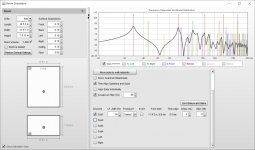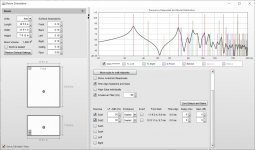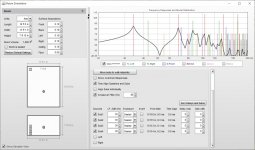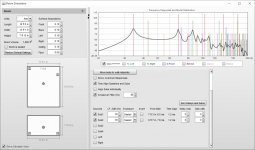As a kid I was entranced by the idea of the Infinity Reference Standard. It was, of course, a 4 tower system, comprised of 2 subwoofer towers, and 2 mid/tweeter arrays.
I'm curious about two things.
Is there a benefit to subwoofers as line arrays? Besides the additional surface area? Do line array 12" drivers have a decided advantage in room mode management? Lets skip the usual smaller = better argument for this conversation please.
Secondly, as I recall, these were early servo controlled subs. In addition to limiting the distortion of the drivers could these have acted as active bass traps?
I'm curious about two things.
Is there a benefit to subwoofers as line arrays? Besides the additional surface area? Do line array 12" drivers have a decided advantage in room mode management? Lets skip the usual smaller = better argument for this conversation please.
Secondly, as I recall, these were early servo controlled subs. In addition to limiting the distortion of the drivers could these have acted as active bass traps?
Last edited:
Does that give a benefit in a pro environment with regards to output? In a domestic situation some might say that this is a disadvantage for subs, or an advantage, it depends on how you use them.
However this system not only appears to be fixed, but also appears to go out of 'sub' territory where the story may be different.
However this system not only appears to be fixed, but also appears to go out of 'sub' territory where the story may be different.
Yes, vertical control, pattern narrowing, increases for line array subs.
Well, that applies to cases where your array dimension is close to the wavelength, but a 40Hz signal is 28 feet, so..... not clear that this holds here.
Well, that applies to cases where your array dimension is close to the wavelength, but a 40Hz signal is 28 feet, so..... not clear that this holds here.
Yeah, it matters, seems any length increase, even when well short of wl, increases on-ax response. Live sound guys have talked about it forever.
Theoretical debate about it ?, ... is why i said i'd leave it to the model folks...
PS....the effective height of ground stacked subs needs to be doubled for the mirror image coming off the ground plane.
Last edited:
Does that give a benefit in a pro environment with regards to output? ....
Nope, there´s a lot of self cancelation going on due to the different path lengths.
One of the reasons why a ridiculous amount of subs is required to do this properly.
But it is a simple to use method to even out sub distribution over a given area by brute force.
In a domestic environment there might be some benefit, if you can build the tower from floor to ceiling, if both are reflective enough in the frequency region of interest.
One could also experiment with beam steering technique to focus on the listening spot.
Regarding the Infinity example: Maybe the designer wanted to match vertical directivity of the low and mid/high towers around crossover
Last edited:
At <100Hz the floor and ceiling are all super reflective. But even with perfect floor and ceiling reflection you only get about 25 feet of effective line in any normal domestic environment. It might be helpful in the upper registers of "sub" territory.
Of course, there are other issues that might turn problematic. The room is really in control of very low frequency response. You will likely find that the place you planned to put your behemoth sub is not the best place for it. Can you now move it to the "right" place? Will it fit? I think these will be more important issues.
Of course, there are other issues that might turn problematic. The room is really in control of very low frequency response. You will likely find that the place you planned to put your behemoth sub is not the best place for it. Can you now move it to the "right" place? Will it fit? I think these will be more important issues.
Ever looked into a mirror through a mirror ?But even with perfect floor and ceiling reflection you only get about 25 feet of effective line in any normal domestic environment
Easy enough to try the idea in REW room sim. It does not look like it helps for a stack of 2 or 4. It would be better to place them separately around the room to even the FR. Only the subs are turned on in the pic below and it looks like the room wins.
.
.
Attachments
I've never used REW for room sims, or even looked at screen shots like you show.
Is kinda looks like REW's room sims are about modes.
Do the sims take in directionality changes?
Particularly vertical in the case of wondering about stacked subs?
In my mind, it seems stacking has to bring in some increased vertical directivity, especially in the upper bass frequencies through xover region.....
In the case of the IRS V, i imagine the tower of 6 12" subs was meant to achieve a better vertical directivity match to the mids, which of course were also in towers.
Cause there would have been easier ways to simply achieve bass output.
Is kinda looks like REW's room sims are about modes.
Do the sims take in directionality changes?
Particularly vertical in the case of wondering about stacked subs?
In my mind, it seems stacking has to bring in some increased vertical directivity, especially in the upper bass frequencies through xover region.....
In the case of the IRS V, i imagine the tower of 6 12" subs was meant to achieve a better vertical directivity match to the mids, which of course were also in towers.
Cause there would have been easier ways to simply achieve bass output.
Last edited:
Sub are usually <100Hz so they are omnidirectional in this range.
[added] - This is for 2 subs and a change in listener position . I've done an experiment with 2 woofers and REW, and it's a pretty good predictor. I moved the mic around to confirm the predicted nulls.
[added] - This is for 2 subs and a change in listener position . I've done an experiment with 2 woofers and REW, and it's a pretty good predictor. I moved the mic around to confirm the predicted nulls.
Attachments
Last edited:
Secondly, as I recall, these were early servo controlled subs. In addition to limiting the distortion of the drivers could these have acted as active bass traps?
That would require an additional input to the control circuitry to "soak up" any incoming waves.
That would require an additional input to the control circuitry to "soak up" any incoming waves.
But aren't servo's attached to drivers effectively microphones??
It's more of a position/motion sensor otherwise known as an accelerometer.. The driver can't operate like a microphone whilst simultaneously being driven, well, I wouldn't have thought soBut aren't servo's attached to drivers effectively microphones??
Last edited:
No problem, I also (not shown) stacked 4 subs evenly spaced up to the ceiling. The room still wins.
Hi DonVK, how did you do that ?
So far, i've only been able to use the REW room simulator to either distribute them in corners or wall midpoints.
Reading the help file, i see all sources are treated as omni, so it appears the simulator is entirely about modes ???
I still have trouble with the idea a vertical stack of subs remains omni, that no directionality takes place.
Going back to the IRS V sub tower. I figure the six 12"s probably made about a 7ft driver span edge to edge. I can't see that length as completely small relative to wavelengths involved, even sub wavelengths.
Because if I use 7ft as a 'vertical diameter', to be able to apply ka type thinking to the directionality in the vertical plane.....
well ....7ft x pi = about 22 ft. 100Hz wl equals about 11ft.
I'm at ka=2 already for 100Hz.
And this ignores any floor reflections that could push ka at 100Hz to 3-4, also creeping some directionality into lower frequencies.
There's also the issue of the sub summation region going to maybe 150Hz or higher, which raises ka's there another 50% or so.
That's just not omni in my book.....
Maybe looking at 'ka implied for the vertical plane only' isn't correct, but I need something to help conceptualize the power ally effects of stacking subs the live sound guys talk about, as well as accounting for the floor mirroring effect I've seen from playing with straight and CBT lines of similar 7 ft height.
Couldn't get logged in to MAPP yesterday to try to sim some sub stacking....someday gonna learn V-Cad which I guess can do it too.
I have a hard time investing in learning sims because how do i know when i made a mistake, or didn't fully understand the underlying assumptions. Sorry for that swerve...my problem
In room sim there are 2 views of the room. To change XY position drag the sub around in the top view. To change the Z position, drag the sub in the lower vertical view. You can also directly enter the sub positions. To change to driver orientation right-mouse-click on the sub, each click rotates driver 90 deg.
I agree, you will get some increase in vertical directivity control as you stack but its not enough at these frequencies. More subs in one location (stack) will give you more bass SPL but does not solve the room problem. The wavelengths (344/50Hz=6.9m) are still large compared to the driver stack and room height. To just "start" to get control (ie. 180deg) at that freq you would need at least a 2.2m diameter woofer. Then there is still the problem of LF reflections in the room which are practically impossible to prevent or absorb.
I agree, you will get some increase in vertical directivity control as you stack but its not enough at these frequencies. More subs in one location (stack) will give you more bass SPL but does not solve the room problem. The wavelengths (344/50Hz=6.9m) are still large compared to the driver stack and room height. To just "start" to get control (ie. 180deg) at that freq you would need at least a 2.2m diameter woofer. Then there is still the problem of LF reflections in the room which are practically impossible to prevent or absorb.
Last edited:
- Status
- This old topic is closed. If you want to reopen this topic, contact a moderator using the "Report Post" button.
- Home
- Loudspeakers
- Multi-Way
- Line Array Sub and Active Theoretical



